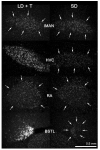Seasonal changes in androgen receptor mRNA in the brain of the white-crowned sparrow
- PMID: 19686750
- PMCID: PMC2824064
- DOI: 10.1016/j.ygcen.2009.08.001
Seasonal changes in androgen receptor mRNA in the brain of the white-crowned sparrow
Abstract
In songbirds, neurons that regulate learned song behavior undergo extensive seasonal plasticity in their number and size in relation to the bird's reproductive status. Seasonal plasticity of these brain regions is primarily regulated by changes in circulating concentrations of testosterone. Androgen receptors are present in all of the major song nuclei, but it is unknown whether levels of androgen receptor mRNA in the telencephalic song regions HVC, the robust nucleus of the arcopallium, and the lateral magnocellular nucleus of the anterior nidopallium change as a function of season in white-crowned sparrows. To determine whether seasonal changes in levels of androgen receptor mRNA are specific to the song control system, we also measured levels of androgen receptor mRNA in a limbic nucleus, the lateral division of the bed nucleus of the stria terminalis (the lateral division of the bed nucleus of the stria terminalis). We found that levels of androgen receptor mRNA were higher in HVC and the lateral division of the bed nucleus of the stria terminalis of birds in the breeding condition compared with the nonbreeding condition; however, we observed no seasonal differences in levels of androgen receptor mRNA in either the robust nucleus of the arcopallium or the lateral magnocellular nucleus of the anterior nidopallium. These results are consistent with previous observations that seasonal plasticity of the song nuclei results from testosterone acting directly on HVC, which then exerts transsynaptic trophic effects on its efferent targets. The seasonal change in the expression of androgen receptor in HVC may be one component of the cellular mechanisms underlying androgenic effects on seasonal plasticity of the song control nuclei.
Copyright 2009 Elsevier Inc. All rights reserved.
Figures



Similar articles
-
Seasonal plasticity of the song control system in wild Nuttall's white-crowned sparrows.J Neurobiol. 1998 Jan;34(1):69-82. doi: 10.1002/(sici)1097-4695(199801)34:1<69::aid-neu6>3.0.co;2-a. J Neurobiol. 1998. PMID: 9469619
-
Seasonal changes in androgen receptor immunoreactivity in the song nucleus HVc of a wild bird.J Comp Neurol. 1999 Jun 28;409(2):224-36. J Comp Neurol. 1999. PMID: 10379916
-
Adult Neurogenesis Leads to the Functional Reconstruction of a Telencephalic Neural Circuit.J Neurosci. 2016 Aug 24;36(34):8947-56. doi: 10.1523/JNEUROSCI.0553-16.2016. J Neurosci. 2016. PMID: 27559175 Free PMC article.
-
Seasonal-like growth and regression of the avian song control system: neural and behavioral plasticity in adult male Gambel's white-crowned sparrows.Gen Comp Endocrinol. 2008 Jul;157(3):259-65. doi: 10.1016/j.ygcen.2008.03.014. Epub 2008 Mar 25. Gen Comp Endocrinol. 2008. PMID: 18457836 Free PMC article. Review.
-
Plasticity of the adult avian song control system.Ann N Y Acad Sci. 2004 Jun;1016:560-85. doi: 10.1196/annals.1298.006. Ann N Y Acad Sci. 2004. PMID: 15313795 Review.
Cited by
-
Androgen and estrogen sensitivity of bird song: a comparative view on gene regulatory levels.J Comp Physiol A Neuroethol Sens Neural Behav Physiol. 2018 Jan;204(1):113-126. doi: 10.1007/s00359-017-1236-y. Epub 2017 Dec 6. J Comp Physiol A Neuroethol Sens Neural Behav Physiol. 2018. PMID: 29209770 Free PMC article. Review.
-
Transsynaptic trophic effects of steroid hormones in an avian model of adult brain plasticity.Front Neuroendocrinol. 2015 Apr;37:119-28. doi: 10.1016/j.yfrne.2014.09.003. Epub 2014 Oct 5. Front Neuroendocrinol. 2015. PMID: 25285401 Free PMC article. Review.
-
Seasonal regulation of behaviour: what role do hormone receptors play?Proc Biol Sci. 2020 Jul 8;287(1930):20200722. doi: 10.1098/rspb.2020.0722. Epub 2020 Jul 8. Proc Biol Sci. 2020. PMID: 32635860 Free PMC article.
-
Preparing to migrate: expression of androgen signaling molecules and insulin-like growth factor-1 in skeletal muscles of Gambel's white-crowned sparrows.J Comp Physiol A Neuroethol Sens Neural Behav Physiol. 2019 Feb;205(1):113-123. doi: 10.1007/s00359-018-1308-7. Epub 2018 Dec 8. J Comp Physiol A Neuroethol Sens Neural Behav Physiol. 2019. PMID: 30535830
-
Testosterone Mediates Seasonal Growth of the Song Control Nuclei in a Tropical Bird.Brain Behav Evol. 2015;86(2):110-21. doi: 10.1159/000437412. Epub 2015 Sep 9. Brain Behav Evol. 2015. PMID: 26346733 Free PMC article.
References
-
- Aste N, Balthazart J, Absil P, Grossmann R, Mulhbauer E, Viglietti-Panzica C, Panzica GC. Anatomical and neurochemical definition of the nucleus of the stria terminalis in Japanese quail (Coturnix japonica) J Comp Neurol. 1998;396:141–57. - PubMed
-
- Atoji Y, Saito S, Wild JM. Fiber connections of the compact division of the posterior pallial amygdala and lateral part of the bed nucleus of the stria terminalis in the pigeon (Columba livia) J Comp Neurol. 2006;499:161–82. - PubMed
-
- Balthazart J, Blaustein JD, Cheng MF, Feder HH. Hormones modulate the concentration of cytoplasmic progestin receptors in the brain of male ring doves (Streptopelia risoria) J Endocrinol. 1980;86:251–61. - PubMed
-
- Bentley GE, Audage NC, Hanspal EK, Ball GF, Hahn TP. Photoperiodic response of the hypothalamo-pituitary-gonad axis in male and female canaries, Serinus canaria. J Exp Zoolog Part A Comp Exp Biol. 2003;296:143–51. - PubMed
-
- Blok LJ, Hoogerbrugge JW, Themmen AP, Baarends WM, Post M, Grootegoed JA. Transient down-regulation of androgen receptor messenger ribonucleic acid (mRNA) expression in Sertoli cells by follicle-stimulating hormone is followed by up-regulation of androgen receptor mRNA and protein. Endocrinology. 1992;131:1343–9. - PubMed
Publication types
MeSH terms
Substances
Grants and funding
LinkOut - more resources
Full Text Sources

